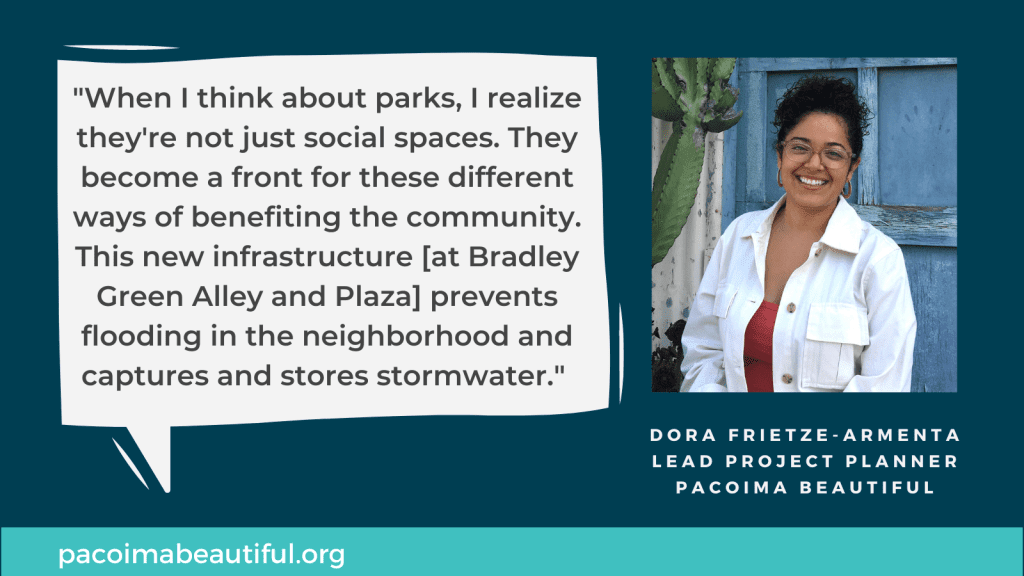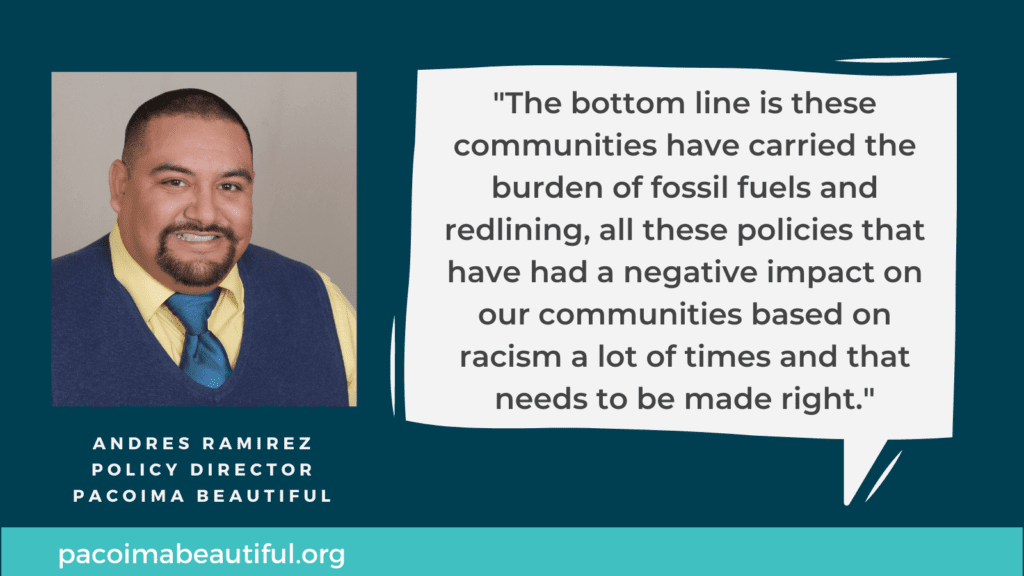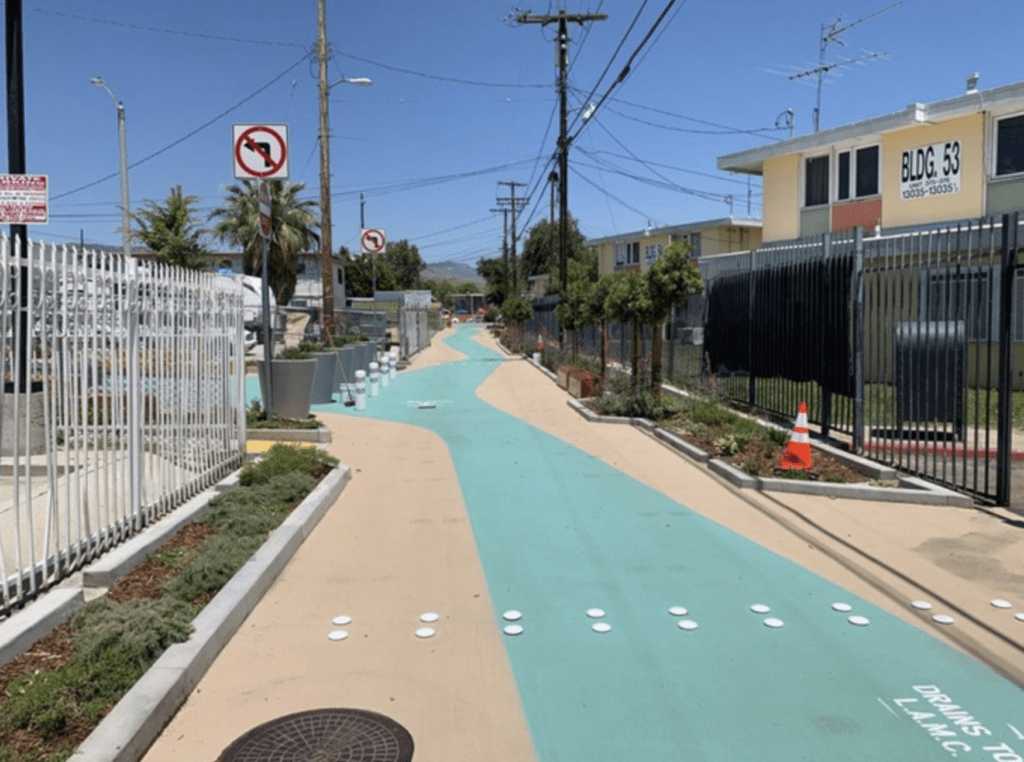Rising Voices is a column the Water Hub pens for Maven’s Notebook listening to advocates and organizers in California talk about water issues impacting local communities. This month, as we’ve seen as extreme heat radiates across the West, we checked in with Pacoima Beautiful’s policy director, Andres Ramirez, and lead project planner, Dora Frietze-Armenta, to talk about what’s going on in Los Angeles’ San Fernando Valley. You can see the original article here and learn more about Maven’s Notebook’s water reporting.
Water Hub (WH): What weather or water issues are top of mind in your community right now?
Andres Ramirez: The rising heat levels are hitting the Valley hard which leads to wildfires getting closer and closer to the communities here. Just last year the fires hit Sylmar which is a working class community. In terms of water issues, drought has unfortunately become normalized here. We have bad stormwater capture infrastructure too so — in the few moments that we do have rain — we get extreme flooding in our community.
WH: What solutions are you seeing locally?
Dora Frietze-Armenta: We talked with graduate students from UCLA’s planning program who created comprehensive plans for green infrastructure solutions. Some of the things we found are that people are extremely resourceful… things like saving water from washing laundry or dishes to water plants was something commonly talked about, as well as creating shade structures in their yards or parking lots to create extra shade in the summer and being moderate consumers in terms of using the AC because folks don’t have the luxury to use AC all day… It’s showing that people do these things out of pure necessity.
Something we talked with the youth about was what they do on hot summer days, and they all said they’re at the park: ‘We’re hanging out at the park, it’s cool, there’s trees, there’s grass and we can just sit around and hang out since it’s several degrees cooler than being at home.’ It’s a relief during the summer and honestly just throughout the entire year.
WH: What changes or resources are needed most?
AR: Continued investment of infrastructure in the community but there has to be a robust engagement of community with these processes because, a lot of times, well-intentioned policies are created in Sacramento or the County but the implementation actually ends up sucking because they’re not talking to the people who are actually impacted. The expertise of the community needs to be valued because folks are the ones living it on the daily and know the solutions that are going to work best for them.
But also, one of the bigger challenges is equitable distribution of resources. Every community, especially affluent communities, get competitive when resources become available and typically those affluent communities have more resources to be more competitive for these monies and that creates the cycle of the highest need communities getting the scraps of resources. We need to change that dynamic. It needs to be a conversation about the highest need communities getting first dibs on these resources because of the historic disinvestment of these communities. It shouldn’t really be a competition. The bottom line is these communities have carried the burden of fossil fuels and redlining, all these policies that have had a negative impact on our communities based on racism a lot of times and that needs to be made right.
DFA: There’s also this real need for long-term investment without having to constantly go through the application processes that comes with maintaining something that’s already been invested in. If there’s investment in green infrastructure, what does that look like in 10-15 years? How is it maintained to ensure that trees don’t just die off? It’s usually the communities of color that are burdened with how to figure it out and scrap it together.

WH: Tell us about the Green Together Collaborative and your work on urban greening?
DFA: The Green Together Collaborative is a group of organizations that are focused on improving the North East San Fernando Valley, specifically Pacoima and Sun Valley. One of the things we’re doing with the Los Angeles Conservation Corps is increasing the tree canopy. Our hope over the next 5 years is to plant 2,000 trees in the project area… Adding 2,000 plus trees means the summers will be cooler, the air will be cleaner, folks that are traveling by foot or waiting for public transportation will be safer when they’re waiting out there.
Another thing to mention is Bradley Plaza, a multi-benefit project that improved an existing plaza and expanded it with trees and greenery but also including a stormwater capture project. When I think about parks, I realize they’re not just social spaces. They become a front for these different ways of benefiting the community. This new infrastructure [at Bradley Green Alley and Plaza] prevents flooding in the neighborhood and captures and stores stormwater. Parks with solar and water infrastructure can really join forces to create tremendous benefits for the surrounding communities.
A photo of Bradley Plaza, a multi-benefit green infrastructure project in Pacoima, California showing a bike path with reflective paving lined with trees and greenery to capture stormwater and cool the local community
WH: Finally, what’s your happy place?
DFA: My happy place is at a park reading a book. I’m one of nine so we grew up pretty poor, we grew up going to the park and the library. We didn’t have AC growing up so we went to the library and if it wasn’t open, we went to the park. That hasn’t changed much for other families like mine, that’s where they go and hang you know? I really love having that kind of social space where I knew when I went, I would see friends and cousins, I knew it was a safe place for me to grow up. It always brings me back to my childhood and the feeling of gratitude that I had those things available to me. Having those memories of music in the background, people playing soccer… you know? Even now when I need a break or feel stressed out, I go to the park.
AR: Taking a bike ride and ending up at a park. Grilling carne asada, having music and dancing. What Dora was saying, it really takes me back. I also grew up in a household without AC so we had to find other solutions to cool down and a lot of time that meant going to a park. Cooling down with a paletero who sells ice cream to us… I’m a sociable person too and I love being around people and building community. So my happy place is meeting with people and connecting with folks in these kinds of places.
Sign up for the Water Hub’s newsletter for more stories from the heart of the water movement, to hear about free communications, trainings, more partner love, and for access to new polling research.

